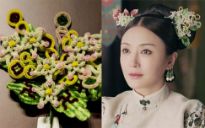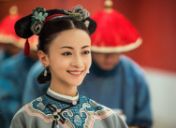As seen on TV
With the fall of the Qing dynasty (1636-1912) and the later puppet empire of Manchukuo (1932-1945), the liangbatou disappeared as the Manchurian population integrated even more into the Han Chinese culture. In the past few years, the liangbatou has experienced a revival with the rise in popularity of palace dramas set in the Qing dynasty.
Shows like ‘Ruyi’s Royal Love in the Palace’ (2018), ‘Empresses in the Palace’ (2011), and the highly popular ‘My Fair Princess’ (1998) all feature ladies in the Qing court who sport the liangbatou. So does the ‘Story of Yanxi Palace’ (2018), which was the most googled TV show in 2018, and was streamed more than 15 billion times on the Chinese streaming service iQiyi.[Cf]
The costumes and hairstyles in the show are part of its success. US$100 million was spent on the show’s costumes and adornments.[Cf] The production team ordered handmade ronghua 绒花 hairpins from a professional handcrafter and received much praise for it. The name of this object is pronounced similarly to the Chinese word for splendor, ronghua 荣华, and was thus associated with good fortune.[Cf] The most famous Chinese fashion blogger on Weibo, gogoboi, who is just short of having 10 million followers, wrote the following:
_Besides clothing and earrings, the head ornaments of the palace maids and concubines in Yanxi Palace are also worth focusing on. (...) It is said that Empress Fuca on a normal day would use “velvet flowers as decorations, not pearls and jade”. You should not underestimate the ronghua decorations on her head. The ronghua was classified as tribute for the royal family during the time of Wu Zetian. (625-705). The making of such ronghua was made UNESCO Intangible Cultural Heritage in 2006.[Cf]. [Read more]
In the same year, the Communist Youth League announced the establishment of Huafu day 华服日 as a celebration of Chinese clothing.[Cf] The terminology is of interest here: there has been a Hanfu 汉服 movement since the 2000s of Chinese youth wearing traditional Han Chinese clothes, not as cosplayers, but as everyday wear. [Cf] The liangbatou and dalachi are not often worn by people in the Hanfu movement, because this is seen as non-Han. However, with the expansion of the term to Huafu, including the minorities of China, the liangbatou is now also included in Huafu movement.




